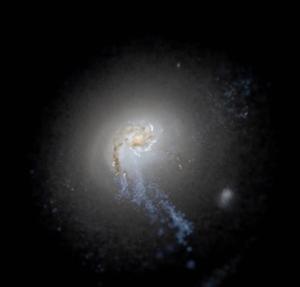A bit of disruption, simulated

This simulated galaxy image, representing a structure spanning more than 200,000 light-years, shows the prominent plumes of young blue stars born in gas that was originally rotating and then blown radially outward by supernova explosions.
It is one of the many hyper-realistic, cosmologically self-consistent computer simulations from the US-based Feedback in Realistic Environments 2 (FIRE-2) project that allow scientists to model the disruptions in otherwise orderly galactic rotations.
Most recently, astronomers led by the University of California, Irvine, have shown that clusters of supernovas can cause the birth of scattered, eccentrically orbiting suns in outer stellar halos.
Writing in the Monthly Notices of the Royal Astronomical Society, they say this finding upends commonly held notions of how star systems have formed and evolved over billions of years.
"These highly accurate numerical simulations have shown us that it's likely the Milky Way has been launching stars in circumgalactic space in outflows triggered by supernova explosions," says senior author James Bullock.
"It's fascinating, because when multiple big stars die, the resulting energy can expel gas from the galaxy, which in turn cools, causing new stars to be born."
Astronomers have long assumed that galaxies are assembled over lengthy periods of time as smaller star groupings come in and are dismembered by the larger body, a process that ejects some stars into distant orbits.
However, the UCI team is proposing "supernova feedback" as a different source for as many as 40 percent of these outer-halo stars.
